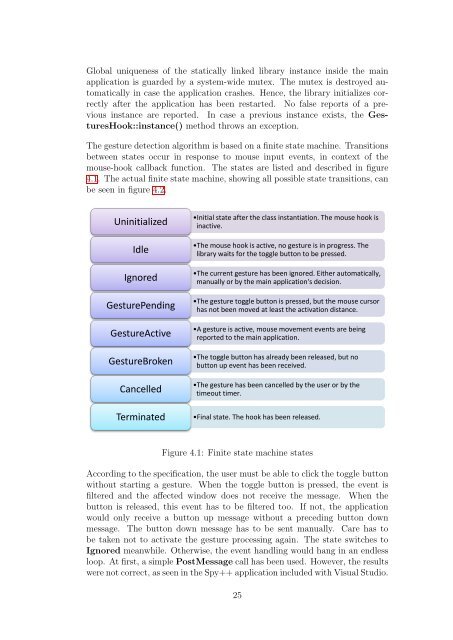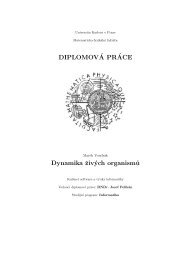Bachelor Thesis - Computer Graphics Group
Bachelor Thesis - Computer Graphics Group
Bachelor Thesis - Computer Graphics Group
Create successful ePaper yourself
Turn your PDF publications into a flip-book with our unique Google optimized e-Paper software.
Global uniqueness of the statically linked library instance inside the main<br />
application is guarded by a system-wide mutex. The mutex is destroyed automatically<br />
in case the application crashes. Hence, the library initializes correctly<br />
after the application has been restarted. No false reports of a previous<br />
instance are reported. In case a previous instance exists, the GesturesHook::instance()<br />
method throws an exception.<br />
The gesture detection algorithm is based on a finite state machine. Transitions<br />
between states occur in response to mouse input events, in context of the<br />
mouse-hook callback function. The states are listed and described in figure<br />
4.1. The actual finite state machine, showing all possible state transitions, can<br />
be seen in figure 4.2.<br />
Uninitialized<br />
Idle<br />
Ignored<br />
GesturePending<br />
GestureActive<br />
GestureBroken<br />
Cancelled<br />
Terminated<br />
•Initial state after the class instantiation. The mouse hook is<br />
inactive.<br />
•The mouse hook is active, no gesture is in progress. The<br />
library waits for the toggle button to be pressed.<br />
•The current gesture has been ignored. Either automatically,<br />
manually or by the main application's decision.<br />
•The gesture toggle button is pressed, but the mouse cursor<br />
has not been moved at least the activation distance.<br />
•A gesture is active, mouse movement events are being<br />
reported to the main application.<br />
•The toggle button has already been released, but no<br />
button up event has been received.<br />
•The gesture has been cancelled by the user or by the<br />
timeout timer.<br />
•Final state. The hook has been released.<br />
Figure 4.1: Finite state machine states<br />
According to the specification, the user must be able to click the toggle button<br />
without starting a gesture. When the toggle button is pressed, the event is<br />
filtered and the affected window does not receive the message. When the<br />
button is released, this event has to be filtered too. If not, the application<br />
would only receive a button up message without a preceding button down<br />
message. The button down message has to be sent manually. Care has to<br />
be taken not to activate the gesture processing again. The state switches to<br />
Ignored meanwhile. Otherwise, the event handling would hang in an endless<br />
loop. At first, a simple PostMessage call has been used. However, the results<br />
were not correct, as seen in the Spy++ application included with Visual Studio.<br />
25
















